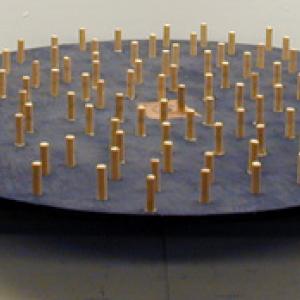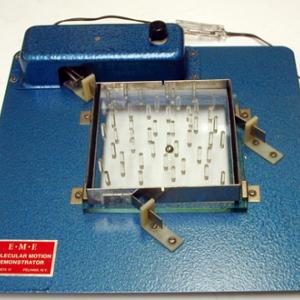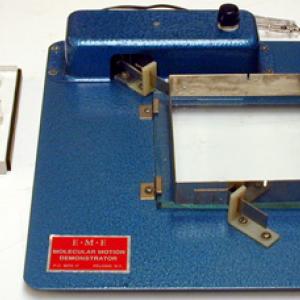College of Liberal Arts & Sciences
8B10.60 - Random Walk
Place one of the neon golf balls in the center of the random walk and turn it on. The speed of the random walk can be varied using the dimmer switch, however the unit usually does not start moving until the dimmer switch is turned almost all the way up. The pegs in the board have different spacing so that depending upon the size of the ball no exclusion, some exclusion, or all exclusion will be observed. A good run on this apparatus will last about 30 seconds.
The molecular motion demonstrator with the plexiglass plate and pins will also do a fair job of showing random walk. This also has the advantage that the particle will not fall out of the apparatus.
Place the containment rails on one of the small tables and secure it in place with the Velcro pieces on the corners and the large orange motorcycle strap. Then place several of the "Bumble Balls" on the small table top which will also give a demonstration of a random walk.
- Christina M. Othon, "Capturing the Random Walk with Toys", TPT, Vol. 61, #2, Feb. 2023, p. 122.
- Mickey Kutzner and Bryan Pearson, "A Student Diffusion Activity", TPT, Vol. 55, #2, Feb. 2017, p. 109.
- Michael J. Burin, "Some Daytime Activities in Solar Astronomy", TPT, Vol. 43, #1, Jan. 2016, p. 36.
- Michael Zeilik, "Modeling Energy Outflow in Stars", TPT, Vol. 37, #4, Apr. 1999, p. 236.
- R. Dean Astumian, "Paradoxical Games and a Minimal Model for a Brownian Motor", AJP, Vol. 73, #2, Feb. 2005, p. 178.
- Cyril Domb and Elmer L. Offenbacher, "Random Walks and Diffusion", AJP, Vol. 46, #1, Jan. 1978, p. 49.
- Diego Krapf and Ralf Metzler, "Strange Interfacial Molecular Dynamics", Physics Today, Vol. 72, #9, Sept. 2019, p. 48.
- Heather M. Hill, "Random Walkers Illuminate a Math Problem", Physics Today, Vol. 72, #9, Sept. 2019, p. 18.
- Borislaw Bilash II and David Maiullo, "How Wide?", A Demo a Day: A Year of Physics Demonstrations, p. 3.
- George H. Weiss, "Random Walks and Their Applications", American Scientist, Vol. 71, #1, Jan-Feb. 1983, p. 65.
- Julien Clinton Sprott, "1.21 Random Walk", Physics Demonstrations, ISBN 0-299-21580-6, p. 60 - 62.
- D. Tattersfield, "5.26. Demonstration 4", Project & Demonstrations in Astronomy, p. 111.
- W. Bolton, "24. Measurement of the Mean Free Path (2)", Book 1. Properties of Materials, Physics Experiments and Projects, 1968, p. 38 - 39.
- W. Bolton, "23. Measurement of the Mean Free Path (1)", Book 1. Properties of Materials, Physics Experiments and Projects, 1968, p. 36 - 37.
- W. Bolton, "22. Mean Free Path", Book 1. Properties of Materials, Physics Experiments and Projects, 1968, p. 34 - 35.
- Caroline Delbert, "Uncovering The Hidden Secrets of Procedural Generation", Popular Mechanics, Sept. / Oct. 2020, p. 22.
- "How Old is Sunlight?", NASA IMAGE Education Center.
Disclaimer: These demonstrations are provided only for illustrative use by persons affiliated with The University of Iowa and only under the direction of a trained instructor or physicist. The University of Iowa is not responsible for demonstrations performed by those using their own equipment or who choose to use this reference material for their own purpose. The demonstrations included here are within the public domain and can be found in materials contained in libraries, bookstores, and through electronic sources. Performing all or any portion of any of these demonstrations, with or without revisions not depicted here entails inherent risks. These risks include, without limitation, bodily injury (and possibly death), including risks to health that may be temporary or permanent and that may exacerbate a pre-existing medical condition; and property loss or damage. Anyone performing any part of these demonstrations, even with revisions, knowingly and voluntarily assumes all risks associated with them.


